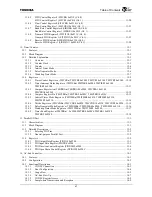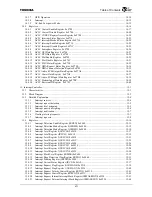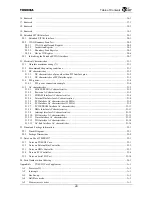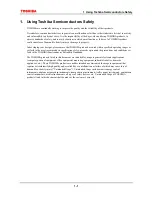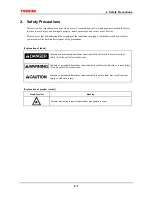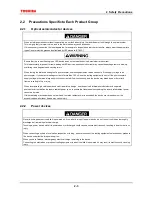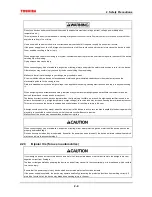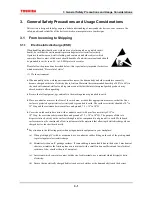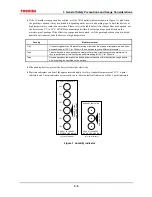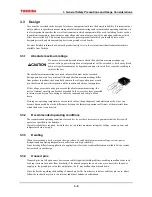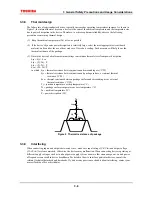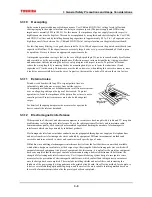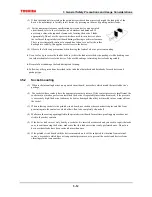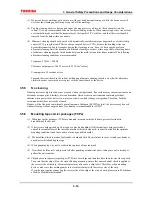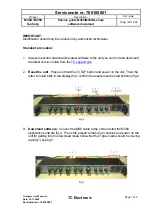
3 General Safety Precautions and Usage Considerations
3-1
3. General Safety Precautions and Usage Considerations
This section is designed to help you gain a better understanding of semiconductor devices, so as to ensure the
safety, quality and reliability of the devices which you incorporate into your designs.
3.1
From Incoming to Shipping
3.1.1
Electrostatic discharge (ESD)
When handling individual devices (which are not yet mounted on a printed circuit
board), be sure that the environment is protected against electrostatic electricity.
Operators should wear anti-static clothing, and containers and other objects which
come into direct contact with devices should be made of anti-static materials and should
be grounded to earth via an 0.5- to 1.0-M
Ω
protective resistor.
Please follow the precautions described below; this is particularly important for devices
which are marked “Be careful of static.”.
(1) Work
environment
•
When humidity in the working environment decreases, the human body and other insulators can easily
become charged with static electricity due to friction. Maintain the recommended humidity of 40% to 60% in
the work environment, while also taking into account the fact that moisture-proof-packed products may
absorb moisture after unpacking.
•
Be sure that all equipment, jigs and tools in the working area are grounded to earth.
•
Place a conductive mat over the floor of the work area, or take other appropriate measures, so that the floor
surface is protected against static electricity and is grounded to earth. The surface resistivity should be 10
4
to
10
8
Ω
/sq and the resistance between surface and ground, 7.5
×
10
5
to 10
8
Ω
•
Cover the workbench surface also with a conductive mat (with a surface resistivity of 10
4
to
10
8
Ω
/sq, for a resistance between surface and ground of 7.5
×
10
5
to 10
8
Ω
) . The purpose of this is to
disperse static electricity on the surface (through resistive components) and ground it to earth. Workbench
surfaces must not be constructed of low-resistance metallic materials that allow rapid static discharge when a
charged device touches them directly.
•
Pay attention to the following points when using automatic equipment in your workplace:
(a) When picking up ICs with a vacuum unit, use a conductive rubber fitting on the end of the pick-up wand
to protect against electrostatic charge.
(b) Minimize friction on IC package surfaces. If some rubbing is unavoidable due to the device’s mechanical
structure, minimize the friction plane or use material with a small friction coefficient and low electrical
resistance. Also, consider the use of an ionizer.
(c) In sections which come into contact with device lead terminals, use a material which dissipates static
electricity.
(d) Ensure that no statically charged bodies (such as work clothes or the human body) touch the devices.
Summary of Contents for TX49 TMPR4937
Page 1: ...64 Bit TX System RISC TX49 Family TMPR4937 Rev 2 0 ...
Page 4: ......
Page 13: ...Table of Contents ix TMPR4937 Revision History 1 ...
Page 14: ...Table of Contents x ...
Page 15: ...Handling Precautions ...
Page 16: ......
Page 18: ...1 Using Toshiba Semiconductors Safely 1 2 ...
Page 40: ...3 General Safety Precautions and Usage Considerations 3 18 ...
Page 42: ...4 Precautions and Usage Considerations 4 2 ...
Page 43: ...TMPR4937 2005 3 Rev 2 0 ...
Page 44: ......
Page 52: ...Chapter 1 Overview and Features 1 6 ...
Page 156: ...Chapter 7 External Bus Controller 7 56 ...
Page 491: ...Chapter 16 Removed 16 1 16 Removed ...
Page 492: ...Chapter 16 Removed 16 2 ...
Page 493: ...Chapter 17 Removed 17 1 17 Removed ...
Page 494: ...Chapter 17 Removed 17 2 ...
Page 495: ...Chapter 18 Removed 18 1 18 Removed ...
Page 496: ...Chapter 18 Removed 18 2 ...
Page 497: ...Chapter 19 Removed 19 1 19 Removed ...
Page 498: ...Chapter 19 Removed 19 2 ...
Page 506: ...Chapter 20 Extended EJTAG Interface 20 8 ...
Page 530: ...Chapter 22 Pinout and Package Information 22 10 ...
Page 542: ...Chapter 24 Parts Number when Ordering 24 2 ...


